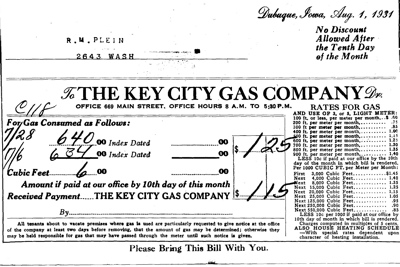Encyclopedia Dubuque
"Encyclopedia Dubuque is the online authority for all things Dubuque, written by the people who know the city best.”
Marshall Cohen—researcher and producer, CNN
Affiliated with the Local History Network of the State Historical Society of Iowa, and the Iowa Museum Association.
KEY CITY GAS COMPANY
KEY CITY GAS COMPANY. The contract for gas lighting with Barker & Spellman provided that the cost to the city should not exceed $2.50 nor to individuals should not exceed $3.50 per thousand feet. The organization became known as the Key City Gas Company.
Key City Gas was begun in Dubuque by Julius K. GRAVES and R. MacArthur in 1853 with a capital of $150,000. This was followed during the same year by the building of gas works. On July 18, 1855, gas was first introduced into the city as source of light. The auxiliary plant at Bluff and Dodge which alone served the city's needs for many years, succeeded the original plant built in 1857. Gas west of the Mississippi was then considered a novelty. A new plant at 11th and Maple STREETS had thirty times the capacity of the original plant.
In 1867, the works were rebuilt at the corner of Bluff and Dodge streets, under the superintendence of Howard & McArthur, and, with the improvements cost $250,000. The new works were located opposite their former site. The purifying building was made of brick, 60x24 feet, containing four purifiers about eight feet square, connecting with pipes to a center " seal," divided into compartments. From this the gas passed into other purifiers, was condensed by a jet of cold water, which removed the carbonic acid gas and other impurities and left the gas ready for use. The retorts were ample, and the reservoir had a capacity of over one hundred thousand cubic feet. The reservoir was sixty-two feet in diameter, by twenty feet deep, and holding 16,800 barrels of water. The walls were three feet thick at the base, twenty-one inches at the top, and water-tight. The meter was manufactured by the American Company, of Philadelphia, and provided quantity of gas produced and consumed each day.
In 1911 the Company had about twelve miles of pipe, 180 city lamps, and furnish lighting facilities to consumers at $3.50 per 1,000 cubic feet.
By the 1920s the Key City Gas Company was the largest coal gas plant in Iowa. In 1927-28 the gas plant, constructed about thirty years before, was remodeled. The additions included fifteen vertical coke ovens installed by the United Gas Improvement Company of Philadelphia. Of German invention, these ovens were the first of their kind constructed in the United States.
The 1913 Dubuque and Dubuque County Directory through the 1929 Dubuque City Directory listed the address as 669-79 Main.
---
Source:
Oldt, Franklin T. The History of Dubuque County. http://www.ebooksread.com/authors-eng/franklin-t-oldt/history-of-dubuque-county-iowa-being-a-general-survey-of-dubuque-county-histor-tdl/page-11-history-of-dubuque-county-iowa-being-a-general-survey-of-dubuque-county-histor-tdl.shtml





